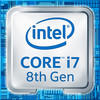Intel Core i7-8650U vs Apple M1 Pro
Intel Core i7-8650U
► remove from comparison
The Intel Core i7-8650U is a power efficient quad-core SoC for notebooks and Ultrabooks based on the Kaby Lake Refresh generation and was announced in August 2017. Contrary to its direct predecessor the Core i7-7600U, which were still dual-cores, the i7-8650U is equipped with four cores but at a lower base frequency of 1.9 GHz. The Turbo Boost can go up to 4,2 GHz and therefore also offer good short term single core speeds. The GPU is now named Intel UHD Graphics 620 but otherwise identical to the Intel HD Graphics 620. The integrated memory controller supports DDR4-2400 / LPDDR3-2133 and dual channel memory.
Architecture
Intel basically uses the same micro architecture compared to Skylake, so the per-MHz performance does not differ. The manufacturer only reworked the Speed Shift technology for faster dynamic adjustments of voltages and clocks, and the improved 14nm process allows much higher frequencies combined with better efficiency than before.
Performance
According to Intel, the new quad core models are up to 40% faster than their dual core predecessors. Due to the reduced TDP and the same 14nm+ process, the long term performance and throttling behaviour will be interesting and depending on the laptop design. Therefore, the older 35 Watt quad-core models should be faster in applications that demand longer CPU loads. The performance however is highly depending on the TDP settings and cooling solution of the laptop. Especially, longer loads will show varying results in different laptops.
Graphics
The integrated Intel UHD Graphics 620 (Intel Gen 9.5) is untouched from the 8th Gen Kaby Lake chips. With fast dual-channel memory it can reach the performance of a dedicated GeForce 920M.
Contrary to Skylake, Kaby lake now also supports H.265/HEVC Main 10 with a 10-bit color depth as well as Google's VP9 codec. The dual-core Kaby Lake processors announced in January should also support HDCP 2.2.
Power Consumption
The chip is manufactured in an improved 14nm process with FinFET transistors (14nm+), the same as the 7th Gen Kaby Lake processors. Intel still specifies the TDP with 15 Watts, which is typical for ULV chips. Depending on the usage scenario, the TDP can vary between 7.5 (cTDP Down) and 25 Watts.
Apple M1 Pro
► remove from comparison
The Apple M1 Pro is a System on a Chip (SoC) from Apple that is found in the late 2021 MacBook Pro 14 and 16-inch models. It offers all 10 cores available in the chip divided in eight performance cores (P-cores with 600 - 3220 MHz) and two power-efficiency cores (E-cores with 600 - 2064 MHz). There is no Turbo Boost for single cores or short burst periods. The cores are similar to the cores in the Apple M1. The entry level model offers only 8 cores.
The big cores (codename Firestorm) offer 192 KB instruction cache, 128 KB data cache, and 24 MB shared L2 cache (up from 12 MB in the M1). The four efficiency cores (codename Icestorm) are a lot smaller and offer only 128 KB instruction cache, 64 KB data cache, and 4 MB shared cache. CPU and GPU can both use the 24 MB SLC (System Level Cache). The efficiency cores (E cluster) clock with 600 - 2064 MHz, the performance cores (P cluster) with 600 - 3228 MHz.
The unified memory (16 or 32 GB LPDDR5-6400) next to the chip is connected by a 256 bit memory controller (200 GB/s bandwidth) and can be used by the GPU and CPU.
The integrated graphics card in the M1 Pro offers all 16 cores.
Furthermore, the SoC integrates a fast 16 core neural engine, a secure enclave (e.g., for encryption), a unified memory architecture, Thunderbolt 4 controller, an ISP, and media de- and encoders (including ProRes).
The M1 Pro is manufactured in 5 nm at TSMC and integrates 33.7 billion transistors. The peak power consumption of the chip was advertised around 30W for CPU intensive tasks. In the Prime95 benchmark the chip uses in our tests (with a MBP16) 33.6W package power and 31W for the CPU part. In idle the SoC only reports 1W package power.
| Model | Intel Core i7-8650U | Apple M1 Pro | ||||||||||||||||||||||||||||||||||||||||
| Codename | Kaby Lake Refresh | |||||||||||||||||||||||||||||||||||||||||
| Series | Intel Kaby Lake Refresh | Apple M1 | ||||||||||||||||||||||||||||||||||||||||
| Series: M1 |
|
| ||||||||||||||||||||||||||||||||||||||||
| Clock | 1900 - 4200 MHz | 2064 - 3220 MHz | ||||||||||||||||||||||||||||||||||||||||
| L1 Cache | 256 KB | 2.9 MB | ||||||||||||||||||||||||||||||||||||||||
| L2 Cache | 1 MB | 28 MB | ||||||||||||||||||||||||||||||||||||||||
| L3 Cache | 8 MB | 24 MB | ||||||||||||||||||||||||||||||||||||||||
| Cores / Threads | 4 / 8 | 10 / 10 | ||||||||||||||||||||||||||||||||||||||||
| TDP | 15 Watt | |||||||||||||||||||||||||||||||||||||||||
| Technology | 14 nm | 5 nm | ||||||||||||||||||||||||||||||||||||||||
| Socket | BGA1356 | |||||||||||||||||||||||||||||||||||||||||
| Features | Dual-Channel DDR4 Memory Controller, HyperThreading, AVX, AVX2, Quick Sync, Virtualization, AES-NI | ARMv8 Instruction Set | ||||||||||||||||||||||||||||||||||||||||
| iGPU | Intel UHD Graphics 620 (300 - 1150 MHz) | Apple M1 Pro 16-Core GPU | ||||||||||||||||||||||||||||||||||||||||
| Architecture | x86 | ARM | ||||||||||||||||||||||||||||||||||||||||
| $409 U.S. | ||||||||||||||||||||||||||||||||||||||||||
| Announced | ||||||||||||||||||||||||||||||||||||||||||
| Manufacturer | ark.intel.com | |||||||||||||||||||||||||||||||||||||||||
| Transistors | 33700 Million |
Benchmarks
Average Benchmarks Intel Core i7-8650U → 100% n=6
Average Benchmarks Apple M1 Pro → 185% n=6
* Smaller numbers mean a higher performance
1 This benchmark is not used for the average calculation













